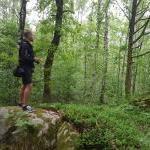20/08/15. Fact #11.
A recent study that attempted to look at the impact of forest-based 'rehabilitation' for patients suffering from severe exhaustion disorder concluded that forest visits should be integrated into part of a wider rehabilitation programme, because of the benefits such visits provide in terms of, particularly, mental well-being.
All visits to the forest were two hours in duration. Patients reported that, once accustomed to the silence (which may have taken several visits), they felt at peace when alone in a forest setting, in addition to feeling safe and secure.
All 19 patients had their own desired places within the forest and agreed that the natural beauty of the forest was appealing, with the vibrant colours, natural sounds of the wind, birds, trees, and other animals was relaxing. Patients also began to look forward to their visits over time, and the visits provided the patients with time to reflect upon their lives and process their thoughts. Positive thinking was improved, as was mood.
Without wanting to drag on, the research project basically concluded that forest visits are very much beneficial, and whilst not a treatment that should be a stand-alone, when coupled with other methods of rehabilitation, access to green space / woodlands / forests is critical.
It's a nice succinct report, and I have linked it below as it's open access.
Source: Sonntag-Öström, E., Stenlund, T., Nordin, M., Lundell, Y., Ahlgren, C., Fjellman-Wiklund, A., Jarvholm, S., & Dolling, A. (2015) “Nature's effect on my mind”–Patients’ qualitative experiences of a forest-based rehabilitation programme. Urban Forestry & Urban Greening. 14 (3). p607-614.






